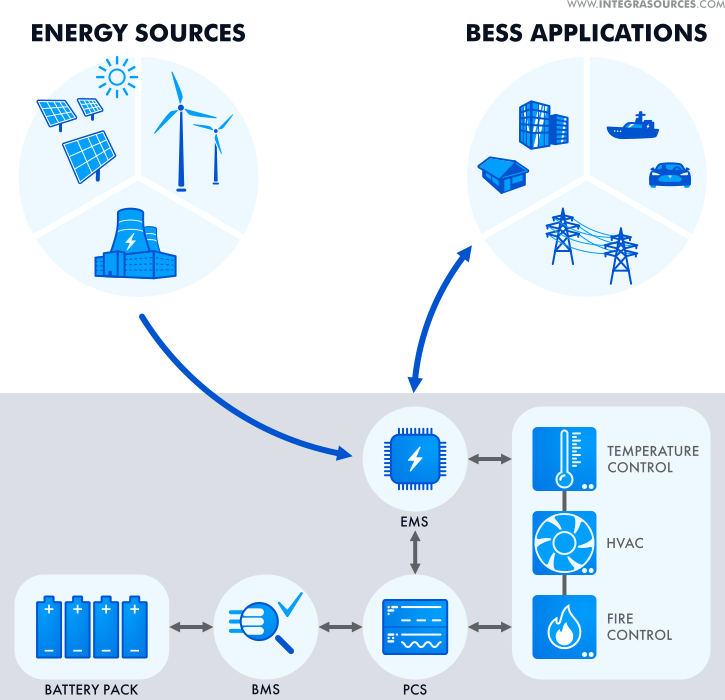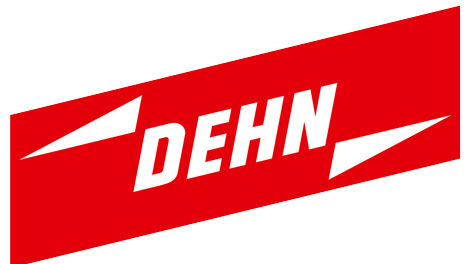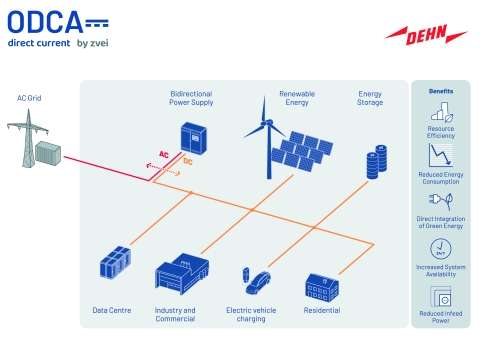DEHN – DEHN joins the Open Direct Current Alliance
DC technology plays a key role in the modern energy landscape.
Whether photovoltaics, battery storage systems or charging stations, DEHN has been dealing with the protection of DC systems for a long time. DEHN’s involvement in the Open Direct Current Alliance therefore marks a further milestone in the lightning and surge protection specialist’s endeavour to shape the future of the electrical industry with innovative and sustainable solutions. DEHN has already successfully participated in the DC-INDUSTRIE research project, which investigated the advantages and potential of DC technologies in industrial applications.
‘Our membership of the Open DC Alliance once again symbolises our commitment to promoting sustainable and innovative energy solutions,’ said Christian Höhler, CTO of DEHN SE. ‘We look forward to being at the forefront of DC technology, alongside other industry leaders, and actively shaping the future of energy supply.’
The Open DC Alliance is a leading consortium dedicated to promoting and standardising DC technologies. As a member of the Alliance, DEHN can contribute to the development and implementation of future-oriented DC solutions that improve the efficiency and environmental impact of the energy supply. DC technologies offer significant environmental benefits. They reduce energy losses and increase energy efficiency which, in turn, reduces CO₂ emissions and allows a more sustainable use of resources.
Renewable energies, like photovoltaic systems, and storage systems, such as fuel cells, can be integrated much more efficiently into a DC grid. That is why direct current is an essential component for the success of the energy transition. The two DC INDUSTRIE research projects reveal that energy consumption in existing systems can be reduced by up to ten per cent. Another benefit is the reduced need for copper in conductors. While conductors with four to five wires are required for alternating voltage, one to two wires less are needed for direct voltage. This represents a copper saving of more than 40 per cent.
For many years, DEHN has been committed to protecting DC systems and offers customised protection solutions. The company has a DC test field where surges and DC networks can be simulated. The specific source characteristics of PV systems can also be reproduced there.
The company was particularly active in the forerunner project DC-INDUSTRIE and was able to gain valuable insights and experience.
These are channelled into pilot projects dealing with DC grids in industrial applications and buildings. DEHN supplies, for example, DC surge arresters for local public transport systems and special surge protection solutions for photovoltaic systems.
Further information on DEHN’s DC range or sustainability efforts (sustainability | DEHN) can be found on our website DEHN – lightning protection, surge protection, safety equipment.
SourceDEHN
EMR Analysis
More information on DEHN: See the full profile on EMR Executive Services
More information on Dr. Philipp Dehn (Chairman of the Board & Chief Executive Officer, DEHN SE + Chairman, ZVEI): See the full profile on EMR Executive Services
More information on Christian Höhler (Chief Technical Officer, DEHN SE): See the full profile on EMR Executive Services
More information on Sustainability and the 2024 Sustainability Report by DEHN: See the full profile on EMR Executive Services
More information on Open Direct Current Alliance (ODCA): https://odca.zvei.org/ + On November 3rd, 2022, the ZVEI founded the Open Direct Current Alliance (ODCA) with 33 companies from industry, universities and research. The ODCA follows on the successful research project DCINDUSTRIE2 and aims to set up a direct current ecosystem worldwide and establish direct current technology across all applications.
In order to further promote the activities of DC grids and to bring them to the market, ZVEI and companies from industry, academia and research founded an Open Direct Current Alliance. The use of DC technology is intended to support and implement the social goal of a resource-saving and CO2-neutral world. The founding of the ODCA is the starting point for moving closer to a resource-saving and CO2-neutral world. With the ODCA, we want to bring the insights and solutions of DC technology into international distribution. DC delivers several benefits for a modern industrial power grid: efficient integration of renewable energy, lower resource consumption, reduced feed-in power, stable grids and an open system for users.
More information on ZVEI: See the full profile on EMR Executive Services
More information on Wolfgang Weber (Chairman of the Executive Board, ZVEI): See the full profile on EMR Executive Services
More information on Dr. Gunther Kegel (President, ZVEI): See the full profile on EMR Executive Services
More information on DC-INDUSTRIE Research Project by ZVEI: https://odca.zvei.org/dc-industrie + The DC-INDUSTRIE projects were successfully completed in March 2023. 45 corporate and research partners worked since 2016 on DC infrastructure, set up and rigorously tested direct current installations in 10 model applications. The findings were then incorporated into the international Open DC Alliance (ODCA) under the umbrella of ZVEI founded in November 2022 and developed further. We would like to take this opportunity to present the project and the findings to you.
EMR Additional Notes:
- AC (Alternating Current) & DC (Direct Current) & UC (Universal Current):
- Direct current (DC) is an electric current that is uni-directional, so the flow of charge is always in the same direction. As opposed to alternating current, the direction and amperage of direct currents do not change. It is used in many household electronics and in all devices that use batteries.
- Direct current has many uses, from the charging of batteries to large power supplies for electronic systems, motors, and more. Very large quantities of electrical energy provided via direct-current are used in smelting of aluminum and other electrochemical processes.
- in contrast to AC power, DC power is entirely made up of active power, meaning that there are almost no losses due to the capacitance of wires when DC power travels long distances. In fact, high voltage AC transmission systems have losses of 7% to 15% with aboveground transmission.
- Alternating Current is used in homes as Direct current can not be easily stepped up or stepped down with the help of transformers whereas alternating current can easily be converted from low voltage to high voltage or vice-versa with the help of transformers.
- “UC” is used for “Universal Current”, that translates to “either DC or AC”. So a 24 V UC input can accept either 24 V AC or 24 V DC.
- Energy Storage System (ESS):
- An energy storage system, often abbreviated as ESS, is a device or group of devices assembled together, capable of storing energy in order to supply electrical energy at a later time. An energy storage system consists of three main components:
- a power conversion system, which transforms electrical energy into another form of energy and vice versa;
- a storage unit, which stores the converted energy;
- a control system, which manages the energy flow between the converter and the storage unit.
- An energy storage system, often abbreviated as ESS, is a device or group of devices assembled together, capable of storing energy in order to supply electrical energy at a later time. An energy storage system consists of three main components:
- Battery Energy Storage System (BESS):
- A BESS is an energy storage system (ESS) that captures energy from different sources, accumulates this energy, and stores it in rechargeable batteries for later use.

- Surge, Transient, Earth and Lightning Protection / Arresters Devices:
- Surge:
- Sudden increase in voltage that lasts for three nanoseconds or more is called a voltage surge.
- Surge protector are also known as Transient Voltage Surge Suppressor (TVSS), Surge Protection Devices (SPD) or Surge Suppression Equipment (SSE). These are equipments designed to protect electrical and electronic equipment from power surges and voltage spikes.
- A surge protector limits the voltage supplied to the electrical devices to a certain threshold, by short-circuiting current to ground or absorbing the spike when a transient occurs, thus avoiding damage to the devices connected to it.
- A surge protector does not interrupt the flow of power. It simply diverts it until the voltage returns to normal. While surge arresters also do this, they often come equipped with a crowbar circuit that acts as a failsafe. If there is a malfunction, the crowbar will interrupt the current.
- Sudden increase in voltage that lasts for three nanoseconds or more is called a voltage surge.
- Transient:
- Temporary unwanted voltage in an electrical circuit that range from a few volts to several thousand volts and last micro seconds up to a few milliseconds.
- => Surge vs. Transient:
- Surges are generally of longer duration but have lower peak voltage and/or current amplitude, while transients are of shorter duration and, usually, higher peak amplitude.
- Earthing and Lighting:
- Earthing ensures that any electrical faults are safely directed to the ground, minimizing the risk of damage or injury usually done by driving ground rods or a horizontal grid of near surface bare conductors under the ground.
- Lightning protection is a system of devices and components designed to protect a building and its occupants from the damaging effects of lightning strikes.
- Surge:
- Carbon Dioxide (CO2):
- Primary greenhouse gas emitted through human activities. Carbon dioxide enters the atmosphere through burning fossil fuels (coal, natural gas, and oil), solid waste, trees and other biological materials, and also as a result of certain chemical reactions (e.g., manufacture of cement). Carbon dioxide is removed from the atmosphere (or “sequestered”) when it is absorbed by plants as part of the biological carbon cycle.
- Biogenic Carbon Dioxide (CO2):
- Biogenic Carbon Dioxide (CO2) and Carbon Dioxide (CO2) are the same. Scientists differentiate between biogenic carbon (that which is absorbed, stored and emitted by organic matter like soil, trees, plants and grasses) and non-biogenic carbon (that found in all other sources, most notably in fossil fuels like oil, coal and gas).
- Decarbonization:
- Reduction of carbon dioxide emissions through the use of low carbon power sources, achieving a lower output of greenhouse gasses into the atmosphere.
- Carbon Footprint:
- There is no universally agreed definition of what a carbon footprint is.
- A carbon footprint is generally understood to be the total amount of greenhouse gas (GHG) emissions that are directly or indirectly caused by an individual, organization, product, or service. These emissions are typically measured in tonnes of carbon dioxide equivalent (CO2e).
- In 2009, the Greenhouse Gas Protocol (GHG Protocol) published a standard for calculating and reporting corporate carbon footprints. This standard is widely accepted by businesses and other organizations around the world. The GHG Protocol defines a carbon footprint as “the total set of greenhouse gas emissions caused by an organization, directly and indirectly, through its own operations and the value chain.”
- CO2e (Carbon Dioxide Equivalent):
- CO2e means “carbon dioxide equivalent”. In layman’s terms, CO2e is a measurement of the total greenhouse gases emitted, expressed in terms of the equivalent measurement of carbon dioxide. On the other hand, CO2 only measures carbon emissions and does not account for any other greenhouse gases.
- A carbon dioxide equivalent or CO2 equivalent, abbreviated as CO2-eq is a metric measure used to compare the emissions from various greenhouse gases on the basis of their global-warming potential (GWP), by converting amounts of other gases to the equivalent amount of carbon dioxide with the same global warming potential.
- Carbon dioxide equivalents are commonly expressed as million metric tonnes of carbon dioxide equivalents, abbreviated as MMTCDE.
- The carbon dioxide equivalent for a gas is derived by multiplying the tonnes of the gas by the associated GWP: MMTCDE = (million metric tonnes of a gas) * (GWP of the gas).
- For example, the GWP for methane is 25 and for nitrous oxide 298. This means that emissions of 1 million metric tonnes of methane and nitrous oxide respectively is equivalent to emissions of 25 and 298 million metric tonnes of carbon dioxide.
- Carbon Capture and Storage (CCS) – Carbon Capture, Utilisation and Storage (CCUS):
- CCS involves the capture of carbon dioxide (CO2) emissions from industrial processes. This carbon is then transported from where it was produced, via ship or in a pipeline, and stored deep underground in geological formations.
- CCS projects typically target 90 percent efficiency, meaning that 90 percent of the carbon dioxide from the power plant will be captured and stored.
- Carbon Dioxide Removal (CDR):
- Carbon Dioxide Removal encompasses approaches and methods for removing CO2 from the atmosphere and then storing it permanently in underground geological formations, in biomass, oceanic reservoirs or long-lived products in order to achieve negative emissions.
- Direct Air Capture (DAC):
- Technologies extracting CO2 directly from the atmosphere at any location, unlike carbon capture which is generally carried out at the point of emissions, such as a steel plant.
- Constraints like costs and energy requirements as well as the potential for pollution make DAC a less desirable option for CO2 reduction. Its larger land footprint when compared to other mitigation strategies like carbon capture and storage systems (CCS) also put it at a disadvantage.
- Carbon Credits or Carbon Offsets:
- Permits that allow the owner to emit a certain amount of carbon dioxide or other greenhouse gases. One credit permits the emission of one ton of carbon dioxide or the equivalent in other greenhouse gases.
- The carbon credit is half of a so-called cap-and-trade program. Companies that pollute are awarded credits that allow them to continue to pollute up to a certain limit, which is reduced periodically. Meanwhile, the company may sell any unneeded credits to another company that needs them. Private companies are thus doubly incentivized to reduce greenhouse emissions. First, they must spend money on extra credits if their emissions exceed the cap. Second, they can make money by reducing their emissions and selling their excess allowances.
- Grid, Microgrids, DERs and DERM’s:
- The power grid is a network for delivering electricity to consumers. The power grid includes generator stations, transmission lines and towers, and individual consumer distribution lines.
- The grid constantly balances the supply and demand for the energy that powers everything from industry to household appliances.
- Electric grids perform three major functions: power generation, transmission, and distribution.
- A microgrid is a small-scale power grid that can operate independently or collaboratively with other small power grids. The practice of using microgrids is known as distributed, dispersed, decentralized, district or embedded energy production.
- Smart Grid is any electrical grid + IT at all levels . Micro Grid is a group of interconnected loads and DERs (Distributed energy resources) within a clearly defined electrical and geographical boundaries witch acts as a single controllable entity with respect to the main grid.
- Distributed energy resources (DERs) are small-scale electricity supply (typically in the range of 3 kW to 50 MW) or demand resources that are interconnected to the electric grid. They are power generation resources and are usually located close to load centers, and can be used individually or in aggregate to provide value to the grid.
- Common examples of DERs include rooftop solar PV units, natural gas turbines, microturbines, wind turbines, biomass generators, fuel cells, tri-generation units, battery storage, electric vehicles (EV) and EV chargers, and demand response applications.
- Distributed energy resources management systems (DERMS) are platforms which helps mostly distribution system operators (DSO) manage their grids that are mainly based on distributed energy resources (DER).
- DERMS are used by utilities and other energy companies to aggregate a large energy load for participation in the demand response market. DERMS can be defined in many ways, depending on the use case and underlying energy asset.


